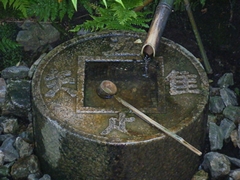Home > Junko's Blog > Resilience and the Steady-State Economy: Japan's Sustainability Lessons from the 2011 Disasters and a Declining Population
February 05, 2013
Resilience and the Steady-State Economy: Japan's Sustainability Lessons from the 2011 Disasters and a Declining Population
from Japan for Sustainability (JFS) Newsletter No.125
http://www.japanfs.org/en/mailmagazine/newsletter/pages/032565.html

According to data on ecological footprints, human activity today is consuming the equivalent of 1.5 planet Earths. But we only have one Earth. Our generation is eating into the assets handed to us from past generations and already borrowing from future generations. We continue to consume more than what just one Earth can provide.

Think of it like a bank account. We can live sustainably if we can survive off the interest, without spending the principal. But today, we are eating up our capital and digging further into the very foundations of human survival. The way we are living is not sustainable.
Why must we humans live on the equivalent of 1.5 Earths in terms of resources? The reasons include an ongoing increase in population, our desire to want and consume more, and so on.
But those are not the only reasons. Another one is that the pursuit of growth is structurally embedded into our very economy and society today. We have to make structural changes of our economy and society, and, based on my observations, I would like to share two aspects of changes that I believe to be important.
The Great East Japan Earthquake, and Resilience as a Component of Sustainability
One perspective guiding my thoughts is from Japan's experience of the Great East Japan Earthquake. On March 11, 2011, a massive earthquake of magnitude 9 and tsunami up to 38 meters in height struck eastern Japan. That disaster, followed by the accident at the Tokyo Electric Power Company's Fukushima Daiichi Nuclear Power Plant gave us many lessons. One of them was that our society had lost its resilience -- the capacity to flexibly recover in any circumstances. We had lost resilience because of the pursuit of short-term benefit.
After the earthquake, the production and distribution of goods ground to a halt across a wide region of Japan. Industries had been structured in a way that ended up bringing things to a complete standstill in the event of a major disruption. They had adopted the ultra-efficient just-in-time system that eliminates inventories, and in some cases had trimmed the number of parts suppliers down to just one, in order to cut costs.
Meanwhile, people who had chosen to make their homes all-electric for convenience and the availability of inexpensive nighttime electricity also experienced hardships after the disaster, because the power blackouts stopped everything. Houses equipped with not only electricity, but also gas, wood stoves and solar panels would fare much better, and it would also help if people could also access electricity generated locally in their own neighborhoods.
Having these kinds of diverse backups ready "just in case" is costly and inefficient in the short-term. The earthquake taught us that our lifestyles, economy and society had suffered the loss of medium to- long-term resilience because of the pursuit of short-term economic efficiency and convenience.
The lesson of the great earthquake was this: "We must recognize the value of what is important even if the value is not visible, even if it cannot be measured with money, and even if it doesn't seem immediately useful." We had only been using short-term, uni-dimensional, economic efficiency as the yardstick of value. We should think about efficiency in a more comprehensive way and take the long-term view of maximizing efficiency, not simply during the business quarter or some other short-term measure.
Also, from the perspective of long-term efficiency, the disaster became an opportunity to reexamine our coexistence with nature. This doesn't just mean being near to and loving nature's beauty and gentleness, but also coexisting and coping with nature's violent characteristics. We need to leave some buffer zones for nature, instead of constructing high coastal dikes and levees and then putting houses and factories right next to them in order to use all the space on the land for human purposes. Setting aside some space will lead to long-term resilience.

This is what the Japanese learned from the community of Aneyoshi in the disaster-affected area. It's a part of Miyako City, on the Omoe Peninsula in Iwate Prefecture. In this community stands an old stone tablet about 60-meters above sea level and 500 meters from the shore, where people are normally busy fishing. After devastating earthquakes and tsunamis hit the area about a century ago, the wisdom has been passed on to younger generations that homes should only be built at elevations higher than the stone marker. People heeded the lessons from their ancestors' experience. The result? In Aneyoshi, no one was killed by the tsunami caused by the earthquake on March 11, 2011. They had designed resilience into their land use decisions.
Based on lessons from the 2011 earthquake experience, businesses have been working to decentralize their production and distribution systems. In cities, people have rediscovered an interest in community association activities that previously they may have thought were a waste of time or a hassle. I see all of this as a sign that people are moving away from a focus on short-term economic efficiency and toward medium-term and long-term resilience.
Thus, one of the messages for sustainability that the Japanese can share after the devastating earthquake is the importance of planning for resilience.
Japan's Era of Declining Population, and the Steady-State Economy as a Component of Sustainability
Another aspect to watch is how Japan develops a vision of sustainability during an era of declining population. After the total Japanese population peaked in 2004, the country entered an era of declining population. In 100 years, Japan might return to the population level of 100 years ago. The change is dramatic, never yet experienced neither in Japan nor abroad. We must also note that since the economic bubble burst at the beginning of the 1990s, the Japanese economy has remained stagnant. The last two decades have been called "the lost 20 years."
This may be problematic from the perspective of economic growth supremacists, but in my opinion, Japan is ahead of the world by being forced to come to terms with the steady-state economy. A steady-state economy means that the economy can be dynamic while its size stays the same. Japan is facing major challenges before the rest of the world has to deal with them. I believe this country is saying goodbye to an era of continuous population growth and a constantly-growing economy. We must design our cities and communities, as well as our very economy and society, based on the idea that the population will decline.
So far, politics has avoided the issue of redistribution by focusing on expanding the "pie." When the economy grows, everybody's share will grow. But when the economy is not steadily growing, the role of politics reverts to its original role of allocating wealth.
In some parts of the world, people have already started to study and put into practice intelligent ways to become smaller while staying happy. We hear about "smart decline" and "shrinking cities."
Indeed, Japan is good at technologies for making things smaller. Those large computers were reduced to palm size. Digital cameras today need no film or developer solution, yet you can take as many pictures as you want. The development of energy-efficient technologies -- the object of fierce corporate competition -- is also about reducing something.
And when it comes to having a steady-state economy, Japan has another advantage -- our experience with the Edo Period. The Edo Period lasted for 265 years, from 1603 to 1867. During that time, the country was closed to the world and experienced no foreign invasions. The country made a tremendous effort to sustain by itself without depending on anything from overseas. It was also quite a peaceful time, with almost no domestic conflicts. In this backdrop, Japan developed its own unique economy and culture.
The country's total population was stable at some 30 million for two and a half centuries, without large fluctuations. Because of its closed-door policy, Japan did not import anything from other countries, but relied on domestic energy and resources. Eisuke Ishikawa, a leading researcher on the Edo Period, estimated that the annual economic growth rate those days was about 0.4 percent. People would not have perceived any economic growth in a lifetime, considering the life expectancy of the time. In that sense, we can say it was a "steady-state economy."

In the Edo Period, people valued the idea of sufficiency, or "taru wo shiru" in Japanese, and they fostered a wonderful and unique culture in the context of an economy and society that was not continually growing. Westerners who visited Japan at the end of the Edo Period left behind many writings praising the Japanese, saying "How polite and cheerful they are, and how happy they look." Of course, the country was not a utopia and had many problems, just like other countries. But still, it can be held up as a model as a sustainable society that used domestic resources sustainably to maintain itself for 265 years.
How can we redirect our society, economy, and lifestyles to value not only short-term economic efficiency but also medium-term and long-term resilience? How can we let go of the delusional mental model that tells us the economy must keep growing? How can we reach some consensus on a sense of values that tells us that what really matters is not continuous economic growth but the creation of happiness in a sustainable economy? How can we change the systems in our economy and society to better match those values? These are challenges for Japan today and the future. And I believe that by tackling these challenges at home, Japan will also have something to offer to the world.
I have introduced two components of sustainability that Japan can suggest: resilience and the steady-state economy. These two are interrelated. Imagine two kinds of bicycles. One rolls at the same safe speed, while the other rolls faster and faster, accelerating. On which bicycle will you find it easier to regain balance after being buffeted by sudden strong winds or when trying to avoid an oncoming car?
Sustainability, I believe, means the continuation of our civilization, of the Earth, of people's wellbeing and happiness. To achieve this, we must stop doing things that will harm sustainability such as climate change and biodiversity loss. And we need to design for resilience, the strength to bounce back whatever happens, since no matter how carefully we plan, it will still be impossible for us to create solutions that will work every time, in all situations.
Japan experienced the disasters of 2011. The country is also entering an era of declining population. Because of these two things, I believe we have something to offer the world along the path to sustainability, by sharing our findings, lessons and adventures as we work, through trial and error, to shift our society toward having a resilient, steady-state economy.





